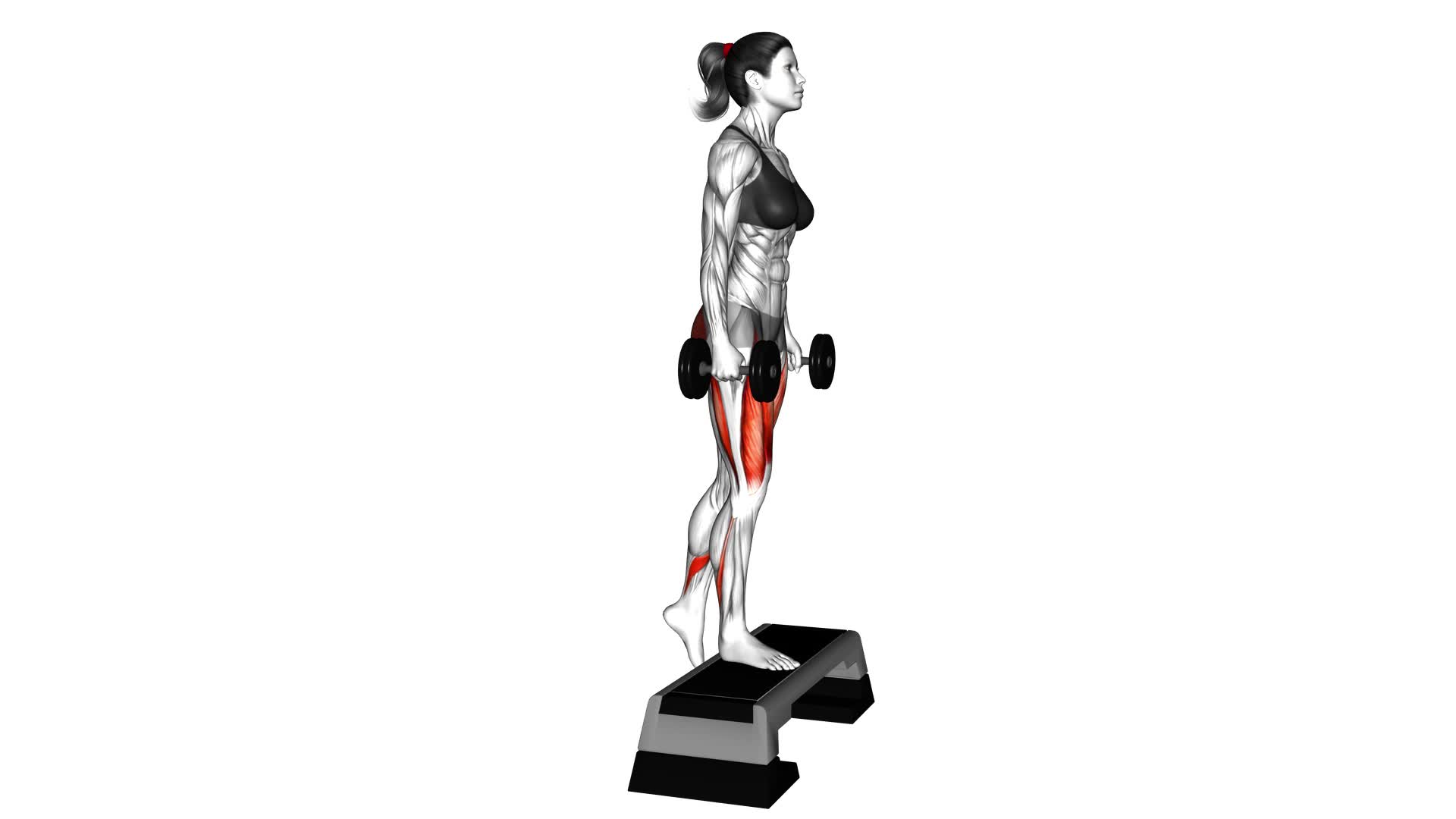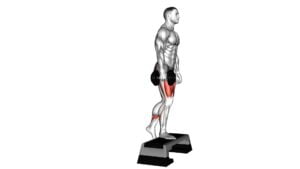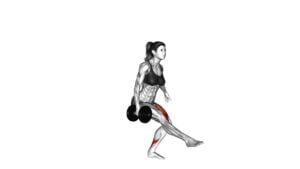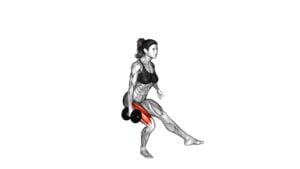Dumbbell Single Leg Step-up (female) – Video Exercise Guide & Tips

Are you looking to tone your lower body and build strength in your legs? The Dumbbell Single Leg Step-up is the perfect exercise for you!
Watch This Exercise Video
In this video exercise guide, we'll show you the proper form and technique, as well as variations to challenge your muscles.
Whether you're a beginner or more advanced, we've got tips to help you master this effective exercise.
Say goodbye to common mistakes and start seeing results today!
Key Takeaways
- The Dumbbell Single Leg Step-up is a highly effective exercise for improving balance and stability in the lower body.
- It targets and strengthens the quadriceps, hamstrings, glutes, and calves, helping to build lean muscle mass.
- Proper form and technique are important to maximize the benefits of the exercise and avoid common mistakes such as not fully extending the leg at the top or allowing the knee to cave inwards.
- Beginners can start with lighter weights and proper form before progressing to single-leg variations or increasing the challenge with heavier weights or higher steps.
Benefits of the Dumbbell Single Leg Step-up
You will experience increased stability and strength in your lower body with the Dumbbell Single Leg Step-up. This exercise is highly effective for improving balance and increasing lower body strength. By performing this exercise regularly, you can strengthen your quadriceps, hamstrings, glutes, and calves. This won't only help you build lean muscle mass but also improve your overall stability and balance.
The Dumbbell Single Leg Step-up requires you to stand facing a bench or step with a dumbbell in each hand. You then step onto the bench with one leg, pushing through your heel to lift your body up. As you reach the top, make sure to engage your glutes and keep your core tight. Slowly lower yourself back down, keeping control of the movement.
Proper form and technique are crucial for maximizing the benefits of this exercise. It's important to maintain proper alignment throughout, keeping your knee tracking over your toes and avoiding any excessive leaning or tilting. Additionally, make sure to use a weight that challenges you without compromising your form.
Proper Form and Technique for the Exercise
To perform the Dumbbell Single Leg Step-up with proper form and technique, start by standing facing a bench or step with a dumbbell in each hand. Place one foot firmly on the bench or step, ensuring that your whole foot is making contact. Keep your knee in line with your toes and maintain a neutral spine throughout the exercise. Engage your core and glutes as you push through your heel to lift your body up onto the bench or step, fully extending your leg. Avoid pushing off with your back foot or using momentum to complete the movement. Control the descent as you lower your body back down, keeping your knee aligned with your toes. Repeat the exercise for the desired number of repetitions before switching legs.
Common mistakes to avoid when performing the Dumbbell Single Leg Step-up include not fully extending your leg at the top, allowing your knee to cave inwards, and leaning too far forward or backward. It's important to maintain proper form to maximize the benefits of this exercise.
The Dumbbell Single Leg Step-up is a great exercise for targeting the muscles of the lower body, including the quadriceps, hamstrings, glutes, and calves. It also helps to improve balance, stability, and coordination. By performing this exercise regularly with proper form and technique, you can strengthen your legs and enhance your overall lower body strength and power.
Variations to Challenge Your Lower Body Muscles
To further challenge your lower body muscles, try incorporating variations of the Dumbbell Single Leg Step-up exercise. These advanced modifications won't only target your glutes, hamstrings, and quadriceps, but they'll also engage your core and improve your balance.
One option is to increase the weight of the dumbbells. By using heavier dumbbells, you'll increase the resistance and make the exercise more challenging. This will help to build strength in your lower body muscles.
Another way to challenge yourself is to perform the exercise on an unstable surface, such as a balance board or a Bosu ball. This will require your muscles to work harder to maintain stability and balance throughout the movement.
You can also try incorporating explosive movements into the exercise, such as adding a jump at the top of the step-up or performing a plyometric lunge after each step-up. These dynamic movements will increase the intensity of the exercise and help to improve your power and agility.
Remember, when attempting these advanced modifications, it's important to use proper form and technique to avoid injury. Start with lighter weights and gradually increase the difficulty as you become more comfortable and stronger. Consult with a fitness professional if you have any concerns or questions about performing these variations safely.
Tips for Beginners to Master the Dumbbell Single Leg Step-up
If you're a beginner looking to master the Dumbbell Single Leg Step-up, focus on maintaining proper form and starting with lighter weights. This exercise can be challenging, but with practice and patience, you can improve your strength and stability. Here are some tips to help you get started:
- Beginner modifications: If you're finding it difficult to balance on one leg, start by performing the step-up exercise with both feet on the ground. This will allow you to build strength in your legs before progressing to the single-leg variation. Additionally, you can use a lower step height to decrease the intensity of the exercise.
- Step-up progressions: Once you feel comfortable with the basic step-up, you can start increasing the challenge. You can do this by using heavier dumbbells or increasing the height of the step. Another progression is to add a knee lift at the top of the movement, engaging your core and working your hip flexors.
- Focus on form: It's important to maintain proper form throughout the exercise. Keep your chest up, shoulders back, and core engaged. As you step up onto the platform, drive through your heel and squeeze your glutes at the top. Make sure to control the movement as you lower yourself back down.
Common Mistakes to Avoid During the Exercise
To avoid common mistakes during the Dumbbell Single Leg Step-up exercise, make sure to focus on maintaining proper form and avoiding these errors.
One common mistake isn't using the proper height for the step. Ensure that the step is at a height that allows your knee to be at a 90-degree angle when your foot is placed on it. This will help engage the correct muscles and prevent unnecessary strain on your joints.
Another mistake isn't keeping your core engaged throughout the movement. Remember to keep your abs tight and your back straight to maintain stability and prevent any excessive leaning or arching.
Additionally, be mindful of your knee position. Avoid letting your knee collapse inward or outward as you step up and down. Keeping your knee aligned with your toes will help maintain proper alignment and prevent any potential knee pain or injury.
Lastly, make sure to control the movement and avoid using momentum to lift your body up. Focus on using the strength of your leg muscles to perform the exercise correctly.
Frequently Asked Questions
What Are the Best Dumbbells to Use for the Single Leg Step-Up Exercise?
When it comes to the single leg step-up exercise, finding the best dumbbell weight for you is key. It's important to choose a weight that challenges you but still allows you to maintain proper form.
If you don't have dumbbells, don't worry! There are alternatives you can use, such as kettlebells or even household items like water bottles or soup cans.
The key is to find a weight that works for you and helps you achieve your fitness goals.
How Many Reps and Sets Should I Do for the Dumbbell Single Leg Step-Up?
For the dumbbell single leg step-up, it's important to focus on proper form and technique.
Start by standing in front of a step or platform with a dumbbell in each hand.
Step one foot onto the platform, pushing through your heel to lift your body up.
Then, slowly lower your body back down.
Aim for 10-12 reps on each leg for 2-3 sets.
Remember to adjust the weight and height of the step based on your fitness level.
Can I Do the Dumbbell Single Leg Step-Up if I Have Knee Pain?
If you have knee pain, it's important to be cautious when doing exercises that involve the knees.
While the dumbbell single leg step-up can be a great exercise for strengthening the legs, it may not be suitable for you if you have knee pain.
It's best to consult with a healthcare professional or a certified trainer to find alternative exercises that can strengthen your legs without aggravating your knee pain.
They can also provide tips on modifying the dumbbell single leg step-up to reduce strain on the knees.
Should I Do the Exercise on a High Step or a Low Step?
To determine whether to do the exercise on a high step or a low step, consider your fitness level and comfort. A high step will engage your glutes and hamstrings more intensely, while a low step will focus on your quads.
If you're a beginner or have knee pain, start with a low step to reduce strain. As you build strength and confidence, you can gradually progress to a higher step for a more challenging workout.
How Long Should I Rest Between Sets for the Dumbbell Single Leg Step-Up?
Resting between sets for the dumbbell single leg step-up is crucial for recovery and maximizing your workout. It's important to listen to your body and give yourself enough time to catch your breath and regain your strength.
Generally, a rest period of 30-60 seconds between sets is recommended. This allows your muscles to recover without losing the intensity of the exercise.
Remember to maintain proper technique and reap the benefits of this challenging exercise.
Conclusion
In conclusion, the dumbbell single leg step-up is a highly effective exercise for targeting the lower body muscles. By performing this exercise with proper form and technique, you can improve your strength, balance, and stability.
There are also variations available to challenge yourself and avoid plateauing. Beginners should focus on mastering the basic movement before progressing. Remember to avoid common mistakes to ensure maximum effectiveness and prevent injury.
Incorporate this exercise into your workout routine for great results.

Author
Years ago, the spark of my life’s passion ignited in my mind the moment I stepped into the local gym for the first time. The inaugural bead of perspiration, the initial endeavor, the very first surge of endorphins, and a sense of pride that washed over me post-workout marked the beginning of my deep-seated interest in strength sports, fitness, and sports nutrition. This very curiosity blossomed rapidly into a profound fascination, propelling me to earn a Master’s degree in Physical Education from the Academy of Physical Education in Krakow, followed by a Sports Manager diploma from the Jagiellonian University. My journey of growth led me to gain more specialized qualifications, such as being a certified personal trainer with a focus on sports dietetics, a lifeguard, and an instructor for wellness and corrective gymnastics. Theoretical knowledge paired seamlessly with practical experience, reinforcing my belief that the transformation of individuals under my guidance was also a reflection of my personal growth. This belief holds true even today. Each day, I strive to push the boundaries and explore new realms. These realms gently elevate me to greater heights. The unique combination of passion for my field and the continuous quest for growth fuels my drive to break new ground.







